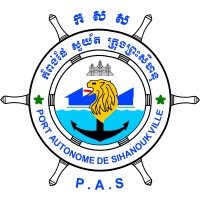
Sihanoukville Autonomous Port
The Sihanoukville Autonomous Port (PAS) is the sole international and commercial deep seaport of the Kingdom of Cambodia. At present, the total operational land area of the Sihanoukville Autonomous Port is around 124.76 ha. The Old Jetty was constructed in 1956 and became operational in 1960. This jetty is 290m long by 28m wide and can accommodate 4 vessels with medium GRT at both sides. The exterior berth is -8.50m -13m depth, while the interior berth is -7.50m -8.50m depth. In order to cope with the increasing rates of cargo throughput the Royal Government of Cambodia had constructed another 350m long new quay with -10.50m maximum draft in 1966. At present, this new quay can accommodate 3 vessels with -7.00m draft medium GRT. The construction of Container Terminal with 400m long by -10.50m depth and 6.5 ha of container yard was fully completed on March 2007.






